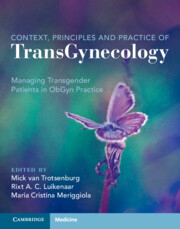Book contents
- Context, Principles, and Practice of Transgynecology
- Context, Principles, and Practice of Transgynecology
- Copyright page
- Dedication
- Contents
- Foreword
- Preface
- Contributors
- Abbreviations
- Section A Contextual Transgynecology
- Section B Practicing Transgynecology
- Chapter 9 Gynecological Office Medicine for Trans and Gender Diverse People
- Chapter 10 Features of Imaging in Transgender Persons
- Chapter 11 Benign Gynecological Conditions in Transgender and Gender Diverse People
- Chapter 12 Urogynecological Disorders
- Chapter 13 Painful and Frequent Micturition
- Chapter 14 Diagnostics and Treatment of Gynecological and Nongynecological Causes of Pelvic Pain
- Chapter 15 Gynecological Attention to the Prostate
- Chapter 16 Vaginal Dilators and Dilating after Vaginoplasty
- Chapter 17 Transenology
- Section C Gynecological Surgery for Transgender Males
- Section D Sexuality and Contraception
- Section E Fertility and Reproduction
- Section F Impact of Gender-affirming Hormonal Therapy on Genital Organs
- Section G Screening and Prophylaxis
- Transgynecology Index
- References
Chapter 11 - Benign Gynecological Conditions in Transgender and Gender Diverse People
from Section B - Practicing Transgynecology
Published online by Cambridge University Press: 22 December 2022
- Context, Principles, and Practice of Transgynecology
- Context, Principles, and Practice of Transgynecology
- Copyright page
- Dedication
- Contents
- Foreword
- Preface
- Contributors
- Abbreviations
- Section A Contextual Transgynecology
- Section B Practicing Transgynecology
- Chapter 9 Gynecological Office Medicine for Trans and Gender Diverse People
- Chapter 10 Features of Imaging in Transgender Persons
- Chapter 11 Benign Gynecological Conditions in Transgender and Gender Diverse People
- Chapter 12 Urogynecological Disorders
- Chapter 13 Painful and Frequent Micturition
- Chapter 14 Diagnostics and Treatment of Gynecological and Nongynecological Causes of Pelvic Pain
- Chapter 15 Gynecological Attention to the Prostate
- Chapter 16 Vaginal Dilators and Dilating after Vaginoplasty
- Chapter 17 Transenology
- Section C Gynecological Surgery for Transgender Males
- Section D Sexuality and Contraception
- Section E Fertility and Reproduction
- Section F Impact of Gender-affirming Hormonal Therapy on Genital Organs
- Section G Screening and Prophylaxis
- Transgynecology Index
- References
Summary
Complaints related to endometriosis, irregular vaginal bleeding, fibroids, chronic recurrent colpitis, urinary tract infections or other benign gynecological conditions can be a heavy burden for patients regardless of one’s gender identity or gender role, but may evolve into an additional source of distress, physically and emotionally, for transgender and gender diverse people.
Healthcare professionals tend to focus on gender incongruence and mitigating symptoms of gender dysphoria, and therefor do not always pay attention to chronic medical conditions to the extent necessary, especially in younger patients.
Diagnostics and treatment of these conditions are not fundamentally different in transgender and gender diverse people, but the stage of transition and the goals of the process towards a satisfactory life, congruent with one’s gender identity, have to be taken into account. Treatment of chronic disorders in general and gynecological complaints in particular should be put into context (of gender-affirmative treatment) and collaboration with other healthcare professionals, including mental healthcare professionals (MHPs), should be sought out to ensure best possible care.
This chapter addresses common benign gynecological conditions and treatment modalities for trans masculine and gender diverse people.
- Type
- Chapter
- Information
- Context, Principles and Practice of TransGynecologyManaging Transgender Patients in ObGyn Practice, pp. 82 - 88Publisher: Cambridge University PressPrint publication year: 2022



